Introducción
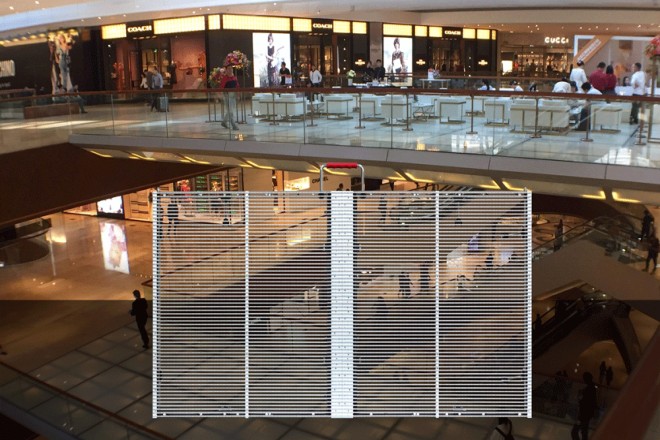
Pantallas LED transparentes, con sus efectos visuales transparentes únicos y su excelente rendimiento, lideran una nueva tendencia en el campo de la exhibición comercial y la publicidad.
Sin embargo, debido a su amplia aplicación, la resolución de problemas y el mantenimiento se han convertido en la clave para garantizar un funcionamiento estable. Este artículo busca analizar en profundidad las posibles fallas y causas de las pantallas LED transparentes y ofrecer soluciones efectivas.
1. Imagen fantasma en la pantalla LED transparente
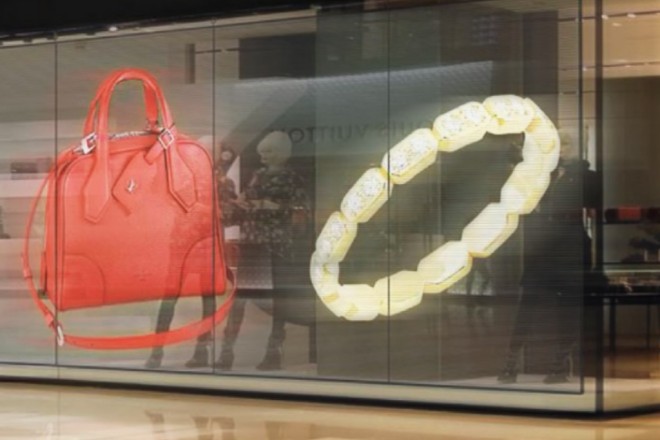
Cuando mira imágenes o vídeos en una pantalla LED transparente, si nota que los bordes de la imagen se vuelven borrosos, como si hubiera dos o más sombras superpuestas, este es el fenómeno llamado "imagen fantasma".
Las imágenes fantasma dificultan el reconocimiento del contenido mostrado y afectan la experiencia de visualización.
1) Análisis de causa
- El frecuencia de actualización no es lo suficientemente rápido:
La frecuencia de actualización se refiere a la cantidad de veces que la pantalla actualiza la imagen por segundo. Si la frecuencia de actualización es demasiado baja, la imagen permanecerá en la pantalla, formando una imagen fantasma, similar a la sensación de ver películas antiguas fotograma a fotograma.
Para las pantallas LED transparentes, la frecuencia de actualización debe ser lo suficientemente alta para garantizar imágenes fluidas sin imágenes superpuestas.
- La transmisión de la señal se ve interferida por:
En el proceso de transmisión de la señal desde la fuente a la pantalla, puede haber interferencias de varios factores externos, como campos electromagnéticos, ondas de radio, etc. Estas interferencias harán que la señal sea inestable, lo que provocará imágenes fantasma en la pantalla.
- Problema con el chip del controlador:
El chip controlador es como el cerebro de la pantalla, responsable de recibir señales y controlar el encendido y apagado de las luces LED para mostrar imágenes. Si el chip controlador falla o se desgasta, la transmisión de la señal será inexacta, lo que provocará imágenes fantasma en la pantalla.
2) Solución
- Aumentar la frecuencia de actualización:
Si el efecto fantasma se debe a una frecuencia de actualización insuficiente, puede intentar ajustar la configuración de la frecuencia de actualización de la pantalla. En general, cuanto mayor sea la frecuencia de actualización, más nítida será la imagen y menor será el efecto fantasma.
- Comprobar la transmisión de la señal:
Para detectar interferencias en la transmisión de señal, verifique si la línea de señal está bien conectada y si sufre interferencias externas. Si es posible, utilice cables blindados o equipos antiinterferentes para reducirlas.
- Reemplace el chip del controlador:
Si se determina que hay un problema con el chip controlador, deberá reemplazarlo por uno nuevo. Esto podría requerir la intervención de técnicos profesionales, ya que el reemplazo del chip controlador implica circuitos complejos y soldadura.
2. Parte de la pantalla LED transparente no se muestra
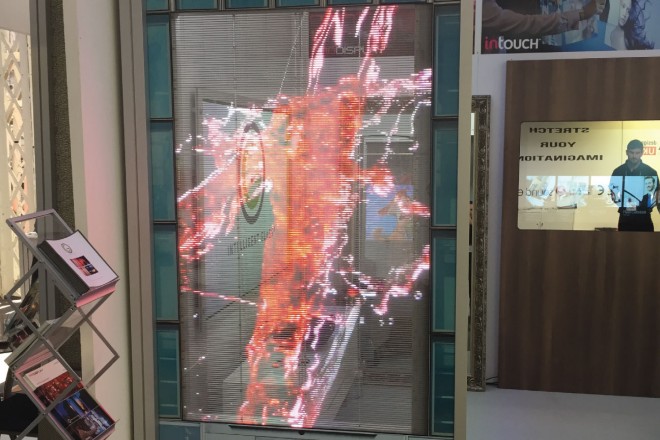
Cuando estás disfrutando del maravilloso contenido en la pantalla LED transparente, de repente, una esquina o un área de la pantalla se oscurece como si estuviera “protegida”, mientras que las otras partes aún se muestran normalmente.
Este fenómeno de no visualización parcial es el problema de “no visualización parcial de la pantalla LED transparente” que vamos a discutir hoy.
1) Análisis de causa
- Insuficiente o interrumpido fuente de alimentación:
La pantalla LED transparente se compone de muchos pequeños Módulos LEDy cada módulo requiere una fuente de alimentación estable para alimentar su luz.
Si la alimentación de energía de un módulo o área es insuficiente, o simplemente se corta, entonces el módulo no funcionará correctamente, dando como resultado una “pantalla negra” en la pantalla.
- Mala conexión del cable de datos:
El cable de datos es como la “red neuronal” de la pantalla, encargado de transmitir la señal que envía la tarjeta de control a cada módulo.
Si el cable de datos está suelto o roto en algún lugar, o si el contacto es deficiente debido al polvo, la suciedad, etc., entonces la señal no puede llegar a un determinado módulo sin problemas y el módulo no puede mostrarse normalmente.
- Tarjeta de control defectuosa:
La tarjeta de control es la encargada de controlar la pantalla LED transparente. Se encarga de procesar los datos de una computadora u otra fuente de señal y convertirlos en una señal que la pantalla pueda interpretar.
Si la tarjeta de control falla, como por un desorden del programa, daño de hardware, etc., es posible que no pueda enviar señales correctamente, lo que provocará que algunas áreas no puedan recibir señales y no se muestren.
2) Solución
- Comprobar y reparar la fuente de alimentación:
Primero, debe verificar la alimentación de la pantalla. Asegúrese de que cada módulo o área tenga una alimentación estable y que no haya suministro insuficiente ni interrupciones debido a un cable de alimentación viejo, mal contacto, etc.
Si se encuentra un problema de energía, debe reemplazar el cable de alimentación viejo a tiempo o reparar el contacto defectuoso.
- Compruebe y reemplace el cable de datos:
A continuación, debe verificar la conexión del cable de datos. Desde la tarjeta de control, revise cada módulo para asegurarse de que la conexión de cada cable sea firme y confiable.
Si el cable de datos está suelto, roto o tiene mal contacto debido a la suciedad, deberá reemplazarlo a tiempo por un cable de datos nuevo o limpiar la suciedad y volver a conectarlo.
- Reemplazar o reparar la tarjeta de control:
Si el problema persiste después de los dos pasos de inspección y reparación mencionados, es probable que la tarjeta de control esté defectuosa. En ese caso, contacte con un técnico profesional para que revise el estado de la tarjeta de control.
Si la tarjeta de control falla, deberá reemplazarla para que la pantalla funcione correctamente. Tenga en cuenta que, antes de reemplazarla, es recomendable hacer una copia de seguridad de los datos originales y asegurarse de que la nueva tarjeta sea compatible con el modelo de pantalla, las especificaciones, etc.
3. El brillo de la pantalla LED transparente es desigual.
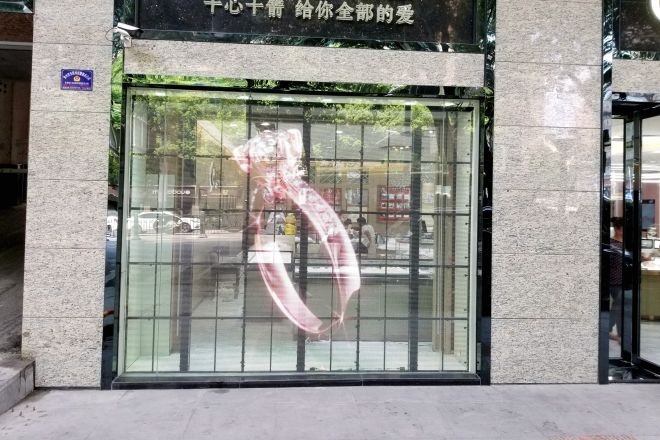
Cuando te paras frente a la pantalla LED transparente, puedes notar que el brillo general de la pantalla no es uniforme, algunos lugares son particularmente brillantes y otros lugares son relativamente oscuros.
Este brillo desigual no solo afecta la belleza general de la pantalla, sino que también puede hacer que las personas se sientan incómodas o producir fatiga visual al mirarla.
1) Análisis de causa
- Envejecimiento natural de las perlas de las lámparas LED:
La pantalla LED transparente está compuesta por miles de perlas de lámpara LED, que envejecerán gradualmente durante el uso a largo plazo.
Al igual que las bombillas de su hogar se atenuarán después de un largo tiempo de uso, las perlas de las lámparas LED también degradarán su rendimiento y reducirán la eficiencia luminosa debido al uso a largo plazo, lo que dará como resultado un brillo desigual en la pantalla.
- Inconsistencia de la corriente de conducción:
Cada lámpara LED requiere una corriente específica para alimentar su luz. Si la corriente de alimentación que recibe cada módulo o lámpara en la pantalla es inconsistente, su brillo también variará.
Esta inconsistencia puede deberse a problemas con el diseño del circuito, la distribución de energía o los chips controladores.
- Acumulación de polvo y suciedad:
La superficie y el interior de la pantalla LED transparente acumulan fácilmente polvo y suciedad. Estas impurezas impiden la entrada de luz, lo que reduce el brillo de la pantalla.
Especialmente cuando el polvo y la suciedad se distribuyen de forma desigual en la superficie de la pantalla, se puede producir una pérdida significativa de brillo. brillo Se formará una diferencia que hará que la pantalla se vea brillante y oscura en una sola pieza.
2) Solución
- Limpie la pantalla periódicamente:
Para mantener el brillo de la pantalla LED transparente, es necesario limpiar la superficie y el interior de la pantalla periódicamente.
Utilice un paño suave y un limpiador especial para limpiar suavemente la superficie de la pantalla y eliminar el polvo y la suciedad acumulados. Asimismo, revise periódicamente el polvo dentro de la pantalla y solicite a un profesional que la limpie.
- Ajuste la corriente de accionamiento:
Si el brillo irregular de la pantalla se debe a una corriente de alimentación inconsistente, debe solicitar a un técnico profesional que ajuste la corriente de alimentación de cada módulo o lámpara. Al ajustar la corriente, cada lámpara puede recibir la misma corriente y emitir luz con el mismo brillo.
- Reemplace las perlas de la lámpara LED viejas:
Las bombillas LED muy antiguas deben reemplazarse a tiempo. Al reemplazarlas, asegúrese de elegir bombillas nuevas del mismo modelo y especificaciones que las originales para garantizar la compatibilidad y el efecto luminoso.
Al mismo tiempo, preste atención al funcionamiento seguro durante el proceso de reemplazo para evitar dañar otras perlas de lámpara o circuitos.
3) Precauciones
Además de las soluciones anteriores, también puede tomar las siguientes precauciones para evitar el problema del brillo desigual de las pantallas LED transparentes:
- Inspección y mantenimiento periódicos:
Inspeccione y mantenga la pantalla regularmente para detectar y solucionar problemas a tiempo. Esto incluye verificar el funcionamiento de componentes clave como la fuente de alimentación, el circuito de control, las bombillas LED, etc.
- Utilice perlas de lámpara LED de alta calidad:
Al comprar pantallas LED transparentes, elija lámparas LED con calidad confiable y rendimiento estable.
Las perlas de lámpara de alta calidad no solo tienen una alta eficiencia luminosa sino que también tienen una larga vida útil, lo que puede reducir los problemas de envejecimiento y brillo desigual.
- Ajuste razonable del brillo:
Ajuste razonablemente el brillo de la pantalla según el entorno y las necesidades del usuario.
Evite el problema del envejecimiento acelerado de las perlas de la lámpara y el brillo desigual causado por el uso prolongado de alto brillo.
Al mismo tiempo, también debemos prestar atención al ahorro de energía y la protección del medio ambiente para evitar el desperdicio innecesario de energía.
4. La pantalla LED transparente tiene una transparencia reducida.
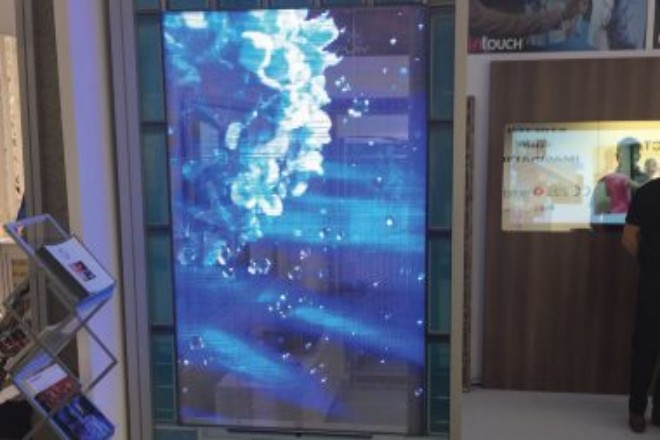
La pantalla LED transparente, con su diseño transparente único, permite que el paisaje detrás complemente el contenido mostrado, brindando una experiencia visual sin precedentes a la audiencia.
Sin embargo, a veces puede notar que esta pantalla, que antes era nítida, pierde transparencia y el paisaje se vuelve borroso o incluso difícil de reconocer. Este es el problema de la menor transparencia de la pantalla LED transparente.
1) Análisis de causa
- “Sucio” en la superficie de la pantalla:
Imagina que si las ventanas de tu casa no se limpian durante mucho tiempo, ¿se acumulará polvo y suciedad? Lo mismo ocurre con las pantallas LED transparentes.
El polvo, la grasa e incluso pequeñas partículas en el aire pueden adherirse a la superficie de la pantalla, formando una “barrera” que bloquea la penetración de la luz y provoca una disminución de la transparencia.
- “Deformación” de la estructura interna:
La pantalla LED transparente se compone de muchos componentes precisos, como perlas de lámpara LED, placas de circuitos, etc. El uso a largo plazo o el impacto de fuerzas externas pueden hacer que estos componentes sufran una ligera deformación o desplazamiento.
Al igual que en un rompecabezas, si una pieza se desvía, la imagen completa se verá inconsistente. Esta deformación de la estructura interna también afecta la trayectoria de la luz, lo que resulta en una disminución de la transparencia.
- La “guerra de diseños” de las cuentas de las lámparas LED:
Las perlas de las lámparas LED son los componentes principales de las pantallas LED transparentes, y su disposición y diseño afectan directamente la transparencia de la pantalla.
Si la disposición de las cuentas de la lámpara es demasiado densa o la disposición no es razonable, será como una pared hermética que bloqueará el paso de la luz.
Además, la eficiencia luminosa y la consistencia del color de las perlas de la lámpara también afectan la transparencia. Si las perlas de la lámpara emiten una luz irregular o el color está distorsionado, se creará una obstrucción visual evidente.
2) Solución
- Dale un “baño” a la pantalla:
Es muy importante limpiar periódicamente la pantalla LED transparente.
Puede usar detergentes profesionales y paños suaves para limpiar suavemente la superficie de la pantalla y eliminar el polvo y la suciedad adheridos. Recuerde evitar usar paños demasiado ásperos o disolventes químicos para no dañar la superficie de la pantalla.
- Estructura interna “examen físico”:
Si la disminución de la transparencia de la pantalla se debe a la deformación de la estructura interna, entonces es necesario solicitar a técnicos profesionales que la inspeccionen y reparen.
Realizarán una inspección exhaustiva de cada componente dentro de la pantalla, descubrirán los componentes deformados o dañados y los repararán o reemplazarán.
- Optimizar la “posición” de las perlas de la lámpara LED:
Para mejorar la transparencia de la pantalla LED transparente, puede considerar optimizar la disposición de las perlas de la lámpara LED.
Según las necesidades reales, ajuste la separación y la disposición de las perlas de la lámpara para garantizar que la luz pase a través de la pantalla sin problemas. Asimismo, es fundamental elegir perlas de lámpara LED con alta eficiencia luminosa y buena consistencia de color.
3) Medidas preventivas
- El mantenimiento regular es esencial:
Al igual que el mantenimiento regular de su coche, las pantallas LED transparentes también requieren mantenimiento regular. Esto no solo permite detectar y solucionar problemas a tiempo, sino que también prolonga la vida útil de la pantalla.
- Tenga cuidado para evitar lesiones:
Al utilizar pantallas LED transparentes, manténgalas con cuidado para evitar impactos y extrusiones por fuerzas externas. Esto previene deformaciones o daños en la estructura interna de la pantalla y mantiene su transparencia.
- El diseño razonable es la clave:
Al diseñar e instalar pantallas LED transparentes, tenga muy en cuenta sus características de transparencia. Elija la disposición de las perlas de la lámpara LED y la eficiencia luminosa adecuadas para garantizar una buena transparencia de la pantalla.
Al mismo tiempo, también se deben considerar la posición de instalación y el ángulo de la pantalla para maximizar el uso de la transmisión de luz.
5. La pantalla LED transparente parpadea o se sacude.
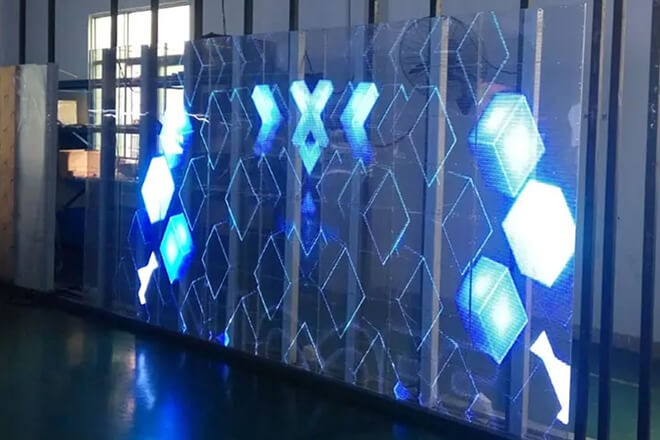
Cuando te paras frente a la pantalla LED transparente, esperando ver una imagen clara y estable, descubres que la imagen en la pantalla parpadea o se sacude constantemente, como si estuvieras viendo una película antigua.
Este fenómeno de parpadeo o vibración no solo hace que las personas se sientan incómodas al mirar, sino que también puede afectar la transmisión precisa de información y reducir el efecto de uso de la pantalla.
1) Análisis de causa
- El “latido inestable” del voltaje de la fuente de alimentación:
Imagina que si tu corazón late de forma inestable, te sentirás incómodo. De igual manera, la pantalla LED transparente también necesita una tensión de alimentación estable para mantenerse activa.
Si el voltaje de la fuente de alimentación fluctúa demasiado, es como darle una “descarga eléctrica” al corazón de la pantalla, lo que provoca que no funcione correctamente y, por lo tanto, parpadee o tiemble.
La inestabilidad del voltaje de suministro de energía puede deberse a fluctuaciones en el voltaje de la red, envejecimiento del equipo de suministro de energía o mala calidad de los cables de suministro de energía.
- “Interferencia de ruido” en la transmisión de señales:
Cuando estás hablando por teléfono con un amigo, si hay mucho ruido alrededor, es posible que no puedas escuchar lo que dice la otra persona.
De manera similar, cuando la pantalla LED transparente recibe señales, si es interferida por interferencias externas, como interferencias electromagnéticas o interferencias de ondas de radio, es como una gran cantidad de "ruido" mezclado en la señal, lo que hace que la pantalla no pueda analizar correctamente la señal, causando así parpadeo o vibración.
Estas interferencias pueden provenir de equipos eléctricos cercanos, equipos de comunicación inalámbrica u otras fuentes electromagnéticas.
- “Golpe” de la tarjeta de control o chip del conductor:
La tarjeta de control y el chip controlador son como el "cerebro" y el "músculo" de la pantalla LED transparente. Si fallan, es como si una persona perdiera el control y la capacidad de actuar, y la pantalla no funcionara correctamente.
La tarjeta de control se encarga de recibir y procesar las señales del ordenador y convertirlas en instrucciones que la pantalla pueda reconocer. El chip controlador se encarga de amplificar estas instrucciones y de activar las perlas de la lámpara LED para que emitan luz.
Si la tarjeta de control o el chip del controlador fallan, es posible que la pantalla no pueda recibir ni procesar correctamente las señales, lo que provoca parpadeos o vibraciones.
2) Solución
- Dale una “pastilla tranquilizadora” al voltaje de la fuente de alimentación:
Para resolver el problema del voltaje de suministro de energía inestable, puede utilizar un voltímetro para detectar la estabilidad del voltaje de suministro de energía.
Si encuentra que el voltaje de la fuente de alimentación fluctúa demasiado, puede intentar reemplazar el cable de alimentación o el equipo de alimentación por uno de mejor calidad.
Al mismo tiempo, también puede comunicarse con la compañía eléctrica o un ingeniero eléctrico profesional para verificar si el voltaje de la red es estable y tomar las medidas adecuadas para resolver el problema.
- “Reducción de ruido” para la transmisión de señales:
Para reducir el impacto de la interferencia de señal en la pantalla LED transparente, puede probar las siguientes medidas:
Utilice cables blindados o equipos antiinterferentes para reducir el impacto de las interferencias externas en la transmisión de la señal. El cable blindado actúa como una "cubierta insonorizante" que aísla el ruido externo.
Mantenga la pantalla alejada de equipos eléctricos o equipos de comunicación inalámbrica que puedan causar interferencias para reducir el impacto de las fuentes de interferencia.
Compruebe periódicamente si la línea de señal de la pantalla está intacta y evite utilizar líneas de señal dañadas o viejas.
- “Cambiar la publicación” de la tarjeta de control o chip del controlador:
Si el problema persiste tras la investigación anterior, es posible que la tarjeta de control o el chip controlador estén defectuosos. En ese caso, puede contactar al proveedor de la pantalla o al personal de mantenimiento profesional para reemplazar la tarjeta de control o el chip controlador.
Durante el proceso de reemplazo, asegúrese de seleccionar una tarjeta de control o un chip controlador que coincida con el modelo de pantalla y siga los pasos correctos para la instalación y la depuración.
3) Medidas preventivas
Para evitar que la pantalla LED transparente parpadee o vibre, puede tomar las siguientes medidas:
Al comprar una pantalla LED transparente, elija una fuente de alimentación y un cable de señal confiables y estables para garantizar el funcionamiento normal de la pantalla.
Realice el mantenimiento e inspección de la pantalla regularmente para detectar y solucionar problemas a tiempo. Esto incluye verificar la estabilidad de la tensión de alimentación, la integridad de la línea de señal y el funcionamiento de la tarjeta de control y el chip controlador.
Al instalar y utilizar la pantalla, tenga cuidado de no colocarla en un entorno donde pueda producirse interferencia, como cerca de líneas eléctricas de alto voltaje, estaciones base de comunicación inalámbrica, etc.
Revise y actualice la tarjeta de control y el chip del controlador regularmente para garantizar su correcto funcionamiento. Si la pantalla no se ha utilizado durante un periodo prolongado, se recomienda reiniciar la máquina regularmente para comprobarla y evitar fallos causados por inactividad prolongada.
Conclusión
En resumen, la resolución de problemas y el mantenimiento de las pantallas LED transparentes son esenciales para garantizar su funcionamiento estable a largo plazo.
Al comprender profundamente las causas y las soluciones de las fallas, combinado con un mantenimiento diario, podemos garantizar que la pantalla continúe mostrando un rendimiento excelente.
Esperamos que la pantalla LED transparente continúe liderando la tendencia tecnológica en el futuro y cree experiencias visuales más maravillosas para los usuarios.
Finalmente, si quieres saber más sobre las pantallas LED, Por favor póngase en contacto con nosotros.
